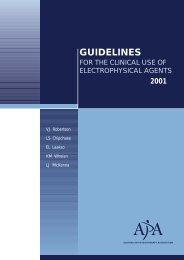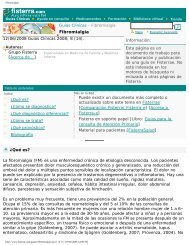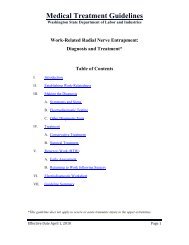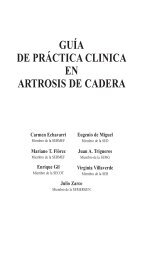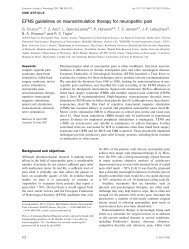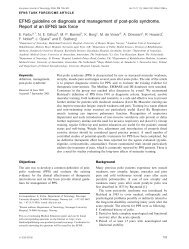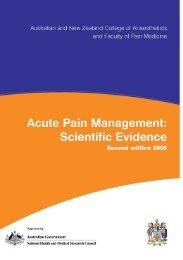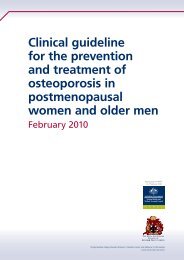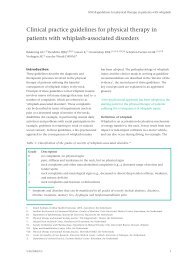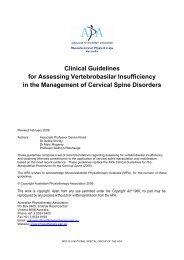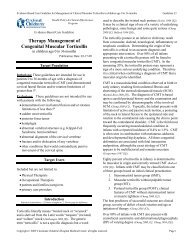Practice Parameter and Literature Review of the Usefulness of ...
Practice Parameter and Literature Review of the Usefulness of ...
Practice Parameter and Literature Review of the Usefulness of ...
Create successful ePaper yourself
Turn your PDF publications into a flip-book with our unique Google optimized e-Paper software.
<strong>Practice</strong> <strong>Parameter</strong>: Carpal Tunnel SyndromeTable 3. Median Motor Nerve Distal Latency in CTS.Author DeLean 57 Jackson <strong>and</strong>Clifford 110 Kimura 130 Padua <strong>and</strong>colleagues 188Padua <strong>and</strong>colleagues 189 Kuntzer 140 Cioni <strong>and</strong>colleagues 47Year 1988 1989 1979 1996 1997* 1994 1989Number <strong>of</strong>Normal H<strong>and</strong>s 80 (43) 38 (38) 122 (61) 40 (36) 70 (70)† 56 (54)(subjects)Normal33 (20 to43 (15 to38 (18 toSubject’s Age:42 (21 to 69)44 (19 to 79) 43 (25 to 70)73)60)68)Mean (range)Number <strong>of</strong> CTS253 (150) 131 (123) 172 (105) 50 (43) 500 (379) 100 (100)† 375 (370)H<strong>and</strong>s (patients)CTS SubjectsAge: Mean(range)Technique:ConductionDistance47 (20 to84)6 cm to 8cm53 (21 to 85)8 cmStimulation Site Wrist Wrist48 (20 to78)Anatomicall<strong>and</strong>marks3 cmproximal towrist crease45 (23 to 80) 51 (20 to 88) 51 (26 to 85)6 cm to 8 cm‡WristAnatomicall<strong>and</strong>marksDistal wristcrease46 (20 to72)Recording Site APB APB APB APB APB APBMinimum H<strong>and</strong>Temperature32°C 31°C 34°C 31°C 32°C 33°CMedian Motor3.2 ± 0.4 3.18 ± 0.27 3.60 ± 0.363.66 ± 0.38Distal Latency ±3.2 ± 0.4 ms§ms msmsmsSDCriteria forAbnormal ValueMean + 2SDMean + 2 SDMean + 2SDMean + 2 SDMean + 2 SD6 cmWrist3.3 ± 0.5 msMean + 2SDAbnormal Value >4.2 ms >3.71 ms >4.4 ms 3.2 ± 0.4 ms§ >4.5 ms >4.3 msSpecificity <strong>of</strong> 99% 95%‡ 97.5%98.6% 97.5%97.5% (estimate)Abnormal Value (estimate) (actual) (estimate)(actual) (estimate)Sensitivity <strong>of</strong>60% 74%‡ 61% 44% 55% 47% 80%Abnormal ValueThe median nerve motor conduction studies cited in Table 3 were performed by fastening surface recording electrodes over <strong>the</strong> <strong>the</strong>nar eminence(G1 or E1) <strong>and</strong> thumb (G2 or E2) <strong>and</strong> supramaximal stimulation <strong>of</strong> <strong>the</strong> median nerve with surface electrodes above <strong>the</strong> wrist crease. With <strong>the</strong>seanatomic l<strong>and</strong>marks, <strong>the</strong> conduction distance is usually 6 to 8 cm in normal adults. The time (latency) from <strong>the</strong> stimulus artifact to <strong>the</strong> initialnegative deflection <strong>of</strong> <strong>the</strong> compound muscle action potential (CMAP) was measured in ms <strong>and</strong> recorded as <strong>the</strong> median motor distal latency(MDL). Slowing <strong>of</strong> median motor nerve conduction in <strong>the</strong> carpal tunnel with nerve injury will result in prolongation <strong>of</strong> <strong>the</strong> median MDL. Becausecooling <strong>of</strong> <strong>the</strong> nerve fibers <strong>and</strong> increasing <strong>the</strong> conduction distance also result in prolongation <strong>of</strong> <strong>the</strong> median nerve MDL, it is important that <strong>the</strong>limb temperature <strong>and</strong> <strong>the</strong> conduction distance be controlled.* 1997 Padua <strong>and</strong> colleagues paper 189 cites reference population studies performed in <strong>the</strong> same laboratory in 1996. 188† For each reference subject, only one h<strong>and</strong> was tested; for each CTS patient, only <strong>the</strong> most symptomatic h<strong>and</strong> was tested.‡ Written communication.§ Written communication: <strong>the</strong> SD <strong>of</strong> <strong>the</strong> normal value was misprinted in <strong>the</strong> 1996 paper, Table 1 (page 50), 3.2 ± 0.8 ms, <strong>and</strong> should have been 0.4ms. The abnormal value (4.0 ms) was published correctly.Specificity equals <strong>the</strong> percentage <strong>of</strong> reference subjects’ h<strong>and</strong>s with normal results <strong>and</strong> was ei<strong>the</strong>r “actual” based on analysis <strong>of</strong> <strong>the</strong> test data from<strong>the</strong> reference population or an “estimate” based on <strong>the</strong> statistical distribution <strong>of</strong> test data from <strong>the</strong> reference population.Sensitivity equals <strong>the</strong> percentage <strong>of</strong> CTS patients’ h<strong>and</strong>s with abnormal results calculated from <strong>the</strong> test data on <strong>the</strong> CTS population.APB = Abductor Pollicis Brevis CTS = Carpal Tunnel Syndrome SD = St<strong>and</strong>ard DeviationMuscle & Nerve Supplement X 2002 S933



